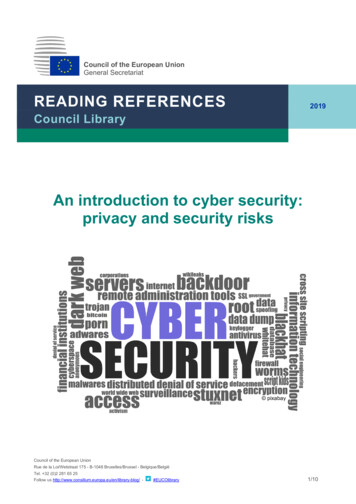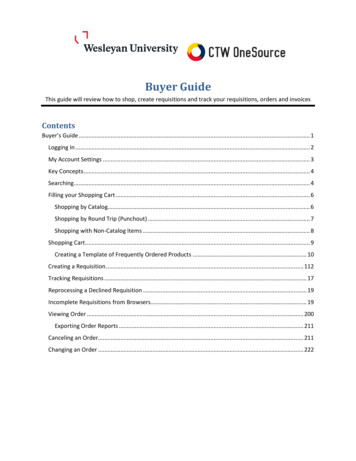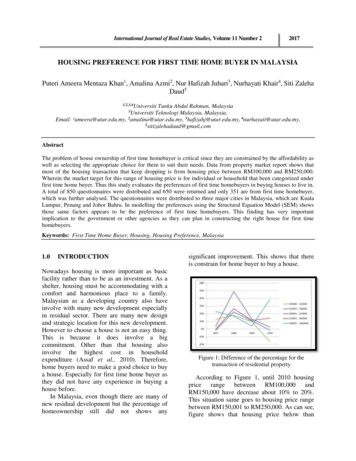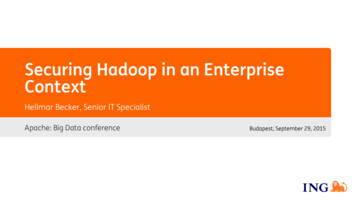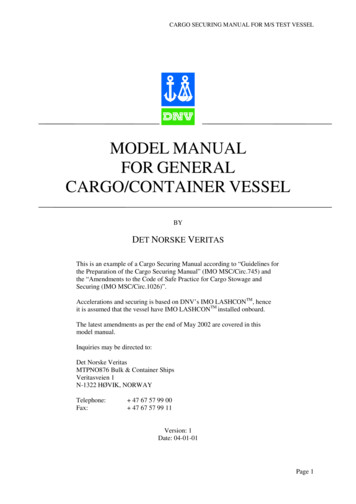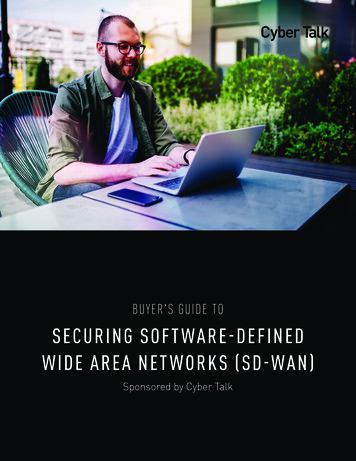
Transcription
BUYER'S GUIDE TOSECURING SOFT WARE-DEFINEDWIDE AREA NET WORKS (SD-WAN)Sponsored by Cyber Talk
SD-WAN SECURITY BUYER'S GUIDE 2TABLE OF CONTENTSThe SD-WAN Revolution. 3SD-WAN: The New Paradigm for Branch Office Networking. 5Top Challenges to Securing Software-DefinedWide Area Networks. 6Top 5 Recommendations for Securing SD-WAN. 71. Basic Next Generation FirewallSignature-Based Inspection. 72. Enterprise-Grade Always Up to DateThreat Prevention Security. 93. Unified Security Management,Security Policy and Threat Visibility. 104. Flexible Deployment Options. 115. Best Security and Best Networking. 13Summary. 14
SD-WAN SECURITY BUYER'S GUIDE 3Introduction: The SD-WAN RevolutionBusinesses are accelerating their digital transformation to cloud SaaS applicationslike Office 365 by adopting Software-Defined WAN technology. SD-WAN providesnetwork innovation by enabling enterprises to connect branches directly to localInternet providers. This improves end user experience significantly by reducing latencycaused by routing traffic through the data center. In addition, local Internet providersgive enterprises more cost effective alternatives to using dedicated networkingprotocols, such as Multiprotocol Label Switching (MPLS) lines. Telecommunicationproviders have also adopted SD-WAN so they can offer SD-WAN as an alternative tothe MPLS lines they already provide to enterprises.SD-WAN adoption is starting to enterHIGHLIGHTSinto the mainstream. Gartner estimatesSD-WAN sales will grow at a 75% CAGRbetween 2017 and 2022.1 However,connecting directly to the Internet usingSD-WAN bypasses datacenter security andexposes branch offices to a range of cyberattacks from basic malware to sophisticatedmulti-vector attacks compromising privacy,data and intellectual property. SD-WAN solutions provide cloud connectivitycloser to the edge removing latency for abetter user experience and lowering costs. Connecting branch office SD-WANs to localinternet providers bypasses datacentersecurity exposing branch offices to cyber attacks. SD-WAN Security solutions should prioritizethreat prevention, flexible deployment options,and scalable management for security policyconsistency.This Guide to Securing Software-Defined Wide Area Networks will review whySD-WAN is popular and recommend how to solve the inherent security challenges.1Gartner: Market Guide for Managed SD-WAN Services, G00366593, 15 May, arket-guide-for-managed-sd-wan-services
SD-WAN SECURITY BUYER'S GUIDE 4Background: Branch Net Working Must EvolveBranch office locations play a crucial role in a wide variety of industries including financial services, retail andhealthcare. The preference to interact with consumers directly for services like banking, insurance, retailand healthcare requires branch offices, clinics and stores to be distributed. In addition, the increase in “edgecomputing” (where data acquired in remote locations is processed locally) is becoming strategic in the drive fordigital transformation.Traditionally, the network architecture to support branch offices was hub and spoke using MPLS, often with aVirtual Private Network (VPN) backup over broadband. This worked well enough when most processing wasdone in the data center, but that approach is no longer attractive for several reasons: According to Gartner, 50% of productivity apps will be moving to cloud by 2022.2 This includes officeproductivity and collaboration applications like video conferencing. Traditional hub and spoke WAN architectures require the data to be routed through the data centerbefore reaching the cloud. This adds latency leading to a poor cloud application user experience:SaaS or IaaS-based applications need high-speed, low latency direct Internet connections, with fullapplication security and performance management. The high cost per unit of bandwidth for MPLS lines that route traffic back to the datacenter A lack of flexibility in combining different types of network links and using them efficiently The delays associated with activating new or temporary branch office sites The need for specialized, expensive engineering and operational skills for router-based networksThese deficiencies have driven the search for a better approach for branch offices, and SD-WAN is the answer.2Gartner 2018 Magic Quadrant for WAN Edge re
SD-WAN SECURITY BUYER'S GUIDE 5SD-WAN: The New Paradigmfor Branch Office NetworkingSD-WAN is revolutionary because it eliminates the keychallenges of legacy networks and delivers lower costs,better flexibility, and a superior cloud user experience. It isno surprise that Gartner expects 90% of branches will useSD-WAN over traditional routers by 2023.3SD-WAN replaces the hub and spoke router-based networkswith software technology that provides these key capabilities:FEATUREWAN OptimizationApplication-Aware Routingfor Best User ExperienceCAPABILIT Y Monitor and optimize network Quality of Service (QOS) Route traffic based on Service Level Agreements (SLA) Identifies applications and routes them through the network based on the bandwidthand service level needed Provides low latency high speed internet connectivity needed for cloud applicationsincluding videoCentralized Network andSecurity Management Centralized network policy-based managementCentralized SecurityManagement Integrate into unified policy and threat management system for simplified operationsZero Touch & Ease of Use Apply network policy applied once to multiple sites saving time and reduces errors Better visibility into threat landscape to identify and quickly mitigate attacks SD-WAN abstracts the underlying technology and presents a graphical, policy-basedoperational interface that is much simpler to understand Zero-touch automated deployment of sitesMixed Use of InternetConnectivity OptionsNetwork-as-a-Service3 Supports mixed use of MPLS and multiple local broadband and wireless (LTE, 4G, 5G, Wi-Fi)internet connections Direct access to local internet connections Cloud service or on-premises implementations Interconnecting cloud, datacenter and branch networking and securityGoogle Transparency Report on HTTPS encryption on the web: eport.google.com/https/overview?hl en
SD-WAN SECURITY BUYER'S GUIDE 6Top Challenges toSecuring Software-DefinedWide Area NetworksAlthough SD-WAN has many networking benefits, it alsocreates serious considerations for security that must beaddressed to avoid creating huge risks to the business.Security issues arise primarily because SD-WANruns business traffic out of the branch locally, withoutbackhauling it to the data center. Furthermore, built-insecurity from SD-WAN providers does not provide thenext-generation threat prevention technologies neededto defend and protect against sophisticated multi-vectorGen V cyber attacks. The security issues that need to beGLOBAL CHEMICAL MANUFACTURERGRACE SECURES CLOUD DIGITALTRANSFORMATION WITH CHECK POINTCLOUDGUARD SOLUTIONS“In the new SD-WAN environment withCloudGuard Connect, we can deploy a sitein five minutes or less — including gettinga cup of coffee in the middle of the process.It is a phenomenal solution that is quick todeploy, built on a very secure platform thatwe’re comfortable with.”– David Antlitz, Global Manager,Security and Firewall Technologies, Graceaddressed include:Inadequate Security Services:You can’t rely on the data center security systems to enforce policy. The same level of enterprisesecurity needs to be provided at the branch office to enable them to securely connect to localinternet providers.Visibility:Security starts with visibility, which is now much harder to attain because branch networking andsecurity need to be distributed.Service Delivery:Remote branch office and retail locations have different networking and security requirements. Someindustries like banking may need on-premises security for data location regulatory requirements.Other locations like retailers may not have the space or supporting staff to manage on-premisessecurity equipment. A “one size fits all” approach to deploying security usually does not work.Inconsistent Policies:The key to effective security is enforcing a consistent policy across the network, but this is difficult ifthere are differences in security services and management.
SD-WAN SECURITY BUYER'S GUIDE 7Scalable Management:Implementing security in dozens or even thousands of sites creates scalability, operations andmanagement challenges.Separation of Duties:Networking and Security in most large enterprises are two different IT disciplines run bydifferent teams. Effective separation of duties will be much harder if security and networkservices are unified in a single SD-WAN architecture and operational interface, but the teamsare not.Top Five Recommendationsfor Securing Software-DefinedWide Area Networks (SD-WAN)What can be done to tackle the security challengescreated by SD-WAN in branch offices?Below are the Top Five Recommendations for securingSD-WAN networks1 BASIC NEXT GENERATION FIREWALLBasic Next Generation Firewall Signature-basedinspection is part of a multi-layered defense and safelyenables branch office employee access to the Internet.Multi-layered defense works best when it is fully integrated.Intrusion Prevention System (IPS)Also known as intrusion detection preventionsystem (IDPS), monitors the network forany malicious attempts to exploit a knownvulnerability. An Intrusion Prevention System’smain function is to identify any suspiciousactivity and either detect and allow (IDS) orprevent (IPS) the threat. The attempt is loggedand reported to the network managers orSecurity Operations Center (SOC) staff.GRACE, GLOBAL CHEMICAL COMPANY,SECURES THEIR SD-WAN WITHCHECK POINTGrace has 18 manufacturing plantsacross 40 countries. They have5000 employees working in officeand manufacturing functions.Challenges: Business has moved from on-premises tocloud-based services including Office 365,AWS and SalesForce, yet network traffic wasstill backhauled to a central data center forInternet access. Business demand had outgrown theirnetwork design; they needed flexibility,performance, and scalability, with the samesecurity they had grown to trust.Solution: Grace implemented VMware SD-WANand Check Point CloudGuard Connect fora secure, stable, better performing, andmore efficient WAN solution. This solution met Grace’s high cybersecurityand performance standards, providing themwith the flexibility to adapt to changingbusiness requirements.
SD-WAN SECURITY BUYER'S GUIDE 8UR LURL and Web FilteringWeb access is a predominant route for attacks on enterprises. URL and Web Filtering controls accessto millions of web sites by category, users, groups, and machines to protect users from malicioussites and enable safe use of the Internet. URL Filtering employs UserCheck technology, whicheducates users on web usage policy in real time.fApplication ControlProvides administrators with the ability to create granular web security policies based on users toidentify, block or limit usage of web applications and widgets. This ensures that the data being usedby and shared between applications is private and secure within an organization.Identity AwarenessProvides granular visibility of users, groups and machines, enabling application and access controlthrough the creation of accurate, identity-based policies.AntivirusProtects computers and removes malicious software or code designed to damage computers or data.Today, malware is evolving so rapidly that some estimate a new malware instance is created nearlyevery second. Today’s antivirus solutions combine global scanning, human expert threat analysis,industry collaboration, cloud integration, and alerting services.Anti-botA botnet is a network of malware-infected computers that can be controlled by a single command andcontrol center operated by a threat actor. The network itself, which can be composed of thousands ifnot hundreds of thousands of computers, is then used to further spread the malware and increasethe size of the network.Encrypted Traffic InspectionA recent Google study showed that over 80% of web traffic generated by end-users using Chrome wasencrypted.4 Unfortunately at the same time, malware creators have learned to leverage CertificationAuthority (CA) automation initiatives like encryption to create phishing sites trusted by browsers.As encrypted traffic and threats proliferate, SD-WAN security solutions must be able to inspectencrypted traffic both to control access and prevent threats. It also must be sophisticated enough tosupport complex policies such as selective decryption so that certain traffic (e.g. employee on-linebanking) can be excluded from decryption to avoid regulatory or liability issues.4Google Transparency Report on HTTPS encryption on the web: eport.google.com/https/overview?hl en
SD-WAN SECURITY BUYER'S GUIDE 92 ENTERPRISE-GRADE ALWAYS UP TO DATE THREAT PREVENTION SECURITYDon’t compromise on branch office security services. Include the full set of enterprise grade security servicesthat branches have come to expect from the datacenter. Branch security starts with protecting against bothknown and unknown threats with the same degree of efficacy.SD-WAN security solutions need to go beyond Next Generation Firewalls to include advanced threat prevention:Threat Prevention versus Detection:Some security solutions focus on detection and response and not threat prevention. You needthreat prevention to protect branch offices against the full range of threats from Zero Day tosophisticated multi-vector attacks. The SD-WAN security solution should include innovativetechnologies like threat emulation (sandboxing), threat extraction (Content Disarm andReconstruction), CPU level inspection, and artificial intelligence.Cloud-based Threat Intelligence:Provides continuous, up-to-date protection against the latest cyber threats. Threat intelligenceis the knowledge businesses have to prevent and/or mitigate the severity and frequency ofcyber attacks. Real-time cloud-based threat intelligence sifts through mounds of data anduses contextual learning and knowledge to identify problems – intuitively separating falsealarms from actual threats – so the proper solutions can be deployed to neutralize the attack.Artificial Intelligence (AI) Security Engines:In addition to threat intelligence, you also need artificial intelligence security engines to minethe mountains of threat data received and to look for trends and anomalies. For example,Check Point’s ThreatCloud intelligence system handles 86 billion security decisions a day. Thatis a lot of data to mine.Sandboxing:Sandboxing prevents the spread of cyber attacks by isolating applications or documents fromthe rest of the IT system. The security system can then inspect the files for unknown or knownattacks before the files are distributed to a user. This provides an extra layer of security thatprevents malware or harmful applications from getting distributed throughout the networkbefore it is determined that they are harmful.
SD-WAN SECURITY BUYER'S GUIDE 103 UNIFIED SECURITY MANAGEMENT, SECURITY POLICY AND THREAT VISIBILITYUnified security policy and threat management will increase security and threat visibility, while reducingoperating expenses up to 40%. Given the distributed nature of branch security, you need a simplified, unifiedsecurity management platform that includes:Unified Security Policy and Threat ManagementIt is essential that you have the same security policy options across the data center and remotes sites. This willallow you to drive policy consistency across the environment, but also to accommodate local variations easily.Key features of a unified security management system include: Unified Security Architecture across the datacenter, networks, branch,mobile, end point and IoT. Unified threat dashboard to assess attack risk across the enterprise. Real-time forensic threat analysis with quick mitigation and compliance.
SD-WAN SECURITY BUYER'S GUIDE 11 A unified threat dashboard makes it far easier to see the complete picture of possible attacks and risksacross the enterprise. This can control security events with real-time forensic and event investigation,compliance and reporting, enabling you to respond to security incidents immediately and reducing thetime spent remediating incidents. Consistent policy and threat management will not only drive greatly improved security and threat visibility,but will also reduce operating expenses.Scalable Distributed NetworkEnsure your management systems and operational model support the level of scale required for highlydistributed security. Many solutions work well when you have a handful of devices and administrators, butcollapse at scale. Time to manually configure a device x increases linearly for every device managed. Thisincludes several dimensions: Number of devices Number and variation of policies, including identity and application awareness Number of simultaneous administratorsA unified threat dashboard makes it far easier to see the complete picture of possible attacks and risks acrossthe enterprise. Consistent policy and threat management will not only drive greatly improved security andthreat visibility, but will also reduce operating expenses.4 FLEXIBLE DEPLOYMENT OPTIONSRemote branch offices are not homogeneous, and can have completely different requirements. For example,financial services, retail and healthcare locations, have different communication and security requirements andIT staff support. It is important to select a vendor that has the ability to provide a variety of SD-WAN securitysolutions that can meet the needs of any branch office. A complete SD-WAN security solution includes thesethree options:1. Cloud Network Security as a service. Does not require any on-premises hardware or IT support,e.g. Check Point CloudGuard Connect.2. Software Virtual Network Function (VNF): On-premises virtual network function (VNF) security gateway.Can be run in an SD-WAN device or branch office server, e.g. Check Point CloudGuard Edge.3. Security Gateway Appliance: on-premises security gateway that secures network traffic coming into andout of the branch office. e.g. Check Point Quantum Security Gateways.
SD-WAN SECURITY BUYER'S GUIDE 12On-Premises RequirementsCompanies in regulated industries like financial services may have data location or privacy requirements thatdon’t allow them to put their data in the cloud. For example, there may be legal requirements to keep certainclasses of data within national boundaries. There may be applications hosted in the branch that require usersto connect to the branch to access resources. Security monitoring of incoming network traffic to the branchis not normally supported by a cloud security service. Cloud services focus on securing branch connectionsto the cloud.For companies who have these types of requirements, either of these two options that we discussed above willmeet your requirements. Software VNF: On-premises virtual network function (VNF) security gateway. Can be run in anSD-WAN device or branch office server, e.g. Check Point CloudGuard Edge. Security Gateway Appliance: on-premises security gateway that secures network traffic coming into andout of the branch office, e.g. Check Point Quantum Security Gateways.The recommended option between the two depends on your performance requirements. A dedicated securitygateway appliance should typically provide better threat prevention performance than a software VNF runninginside a SD-WAN device or branch server.
SD-WAN SECURITY BUYER'S GUIDE 13Cloud Network Security as a ServiceOn the other hand, cloud-based security services are easy to scale and support, and eliminate CapEx costs.They can provide security in branches with little or no IT support like retail locations. Look for a cloud networksecurity service with: A cloud native architecture that is low latency, elastic, scalable, with 99.999% uptime Always up to date with advanced NSS top-rated threat prevention Maintenance-free security service that can be delivered to branch offices in minutes5 BEST SECURITY AND BEST NETWORKINGLook for solutions that combine leading SD-WAN providers like VMware, Silver Peak, Cisco, and Citrix withthe top security providers like Check Point. This is a no-compromise approach that gives you the best of bothworlds. Below we have outlined the key security and SD-WAN features that will deliver the Best SD-WANSecurity and Best SD-WAN Networking.Best SD-WAN SecurityTHREAT PREVENTIONUNIFIED MANAGEMENTFLEXIBLE SECURIT Y OPTIONSThreat Emulation (Sandboxing)Unified Security PolicyNetwork SaaSCPU Level InspectionUnified Threat DashboardVirtual Network FunctionAI & Threat IntelligenceReal-Time ForensicsSecurity AppliancesAPPLICATION BASED ROUTINGCENTRALIZED MANAGEMENTAND CONFIGURATIONWAN OPTIMIZATIONIdentifying Apps in the NetworkLarge Scale, Profile BasedQOS, Monitoring and Improve SLA.and Routing AccordinglyCentral ManagementRoute Selection Based on SLAZERO TOUCH & EASE OF USEEDGE APPLIANCENET WORK-AS-A-SERVICEZero-Touch and AutomatingProviding Multiple ISPInterconnecting Cloud,DeploymentWi-Fi, 4G/LTE CapabilitiesDatacenter and BranchesBest SD-WAN Networking
SD-WAN SECURITY BUYER'S GUIDE 14In addition, despite the SD-WAN paradigm change, security and networking remain different disciplines inmany IT organizations. Therefore, ensure that your architecture allows complete separation of duties, so thatsecurity and network policies can be decoupled operationally. This will decrease the friction associated withSD-WAN adoption, and will ease the burden of meeting compliance requirements.SummarySoftware-Defined WAN (SD-WAN) is indeed a revolution in network architectures enabling businesses toaccelerate their digital transformation to cloud SaaS applications like Office365. Enterprises can now leveragea variety of less expensive local Internet providers without sacrificing cloud application performance. This alsoenables companies to still use MPLS lines when dedicated bandwidth is required. Because SD-WAN improvesthe cloud application user experience while also reducing communication costs, we expect SD-WAN to becomeubiquitous over the next several years.Although SD-WAN has many virtues, it also creates serious considerations for security that must be addressedto avoid creating huge risks to the business. The security issues arise because SD-WAN enables branchesto connect to local internet providers bypassing datacenter security and exposing them to cyber attacks.Furthermore, built-in security from SD-WAN providers does not provide the next-generation threat preventiontechnologies needed to defend and protect against sophisticated multi-vector Gen V cyber attacks.To mitigate these challenges, cyber security experts recommend that branches implement the sameenterprise-grade security delivered by the datacenter. SD-WAN security solutions need to go beyond NextGeneration Firewalls to include the following: Enterprise-Grade Always Up to Date Threat Prevention Security Unified and Scalable Security Management with unified policy and threat visibility Flexible Deployment Options on-premises and in the cloud including:o Cloud network security as a serviceo Virtual security appliance (VNF) that runs on a SD-WAN device or branch serveo Security appliance Demand the Best Security and Best Networking. Look for solutions that combine leading SD-WANproviders like VMware, Silver Peak, Cisco, and Citrix with the top security providers like Check Point.This is a no-compromise approach that gives you the best of both worlds.
SD-WAN SECURITY BUYER'S GUIDE 15If you are considering moving to SD-WAN, seriously consider implementing Check Point CloudGuard Connectservice, CloudGuard Edge VNF, or a branch security appliance. These three SD-WAN solutions secure connectionsto the cloud with top-rated threat prevention, quick and easy deployment, and unified security management andthreat visibility saving enterprises up to 40% in operating expenses.For more information, go int.com/products/branch-office-security/Worldwide Headquarters5 Ha’Solelim Street, Tel Aviv 67897, Israel Tel: 972-3-753-4555 Fax: 972-3-624-1100 Email: info@checkpoint.comU.S. Headquarters959 Skyway Road, Suite 300, San Carlos, CA 94070 Tel: 800-429-4391; 650-628-2000 Fax: 650-654-4233www.checkpoint.com 2020 Check Point Software Technologies Ltd. All rights reserved.
Web access is a predominant route for attacks on enterprises. URL and Web Filtering controls access to millions of web sites by category, users, groups, and machines to protect users from malicious sites and enable safe use of the Internet. URL Filtering employs UserCheck technology, which educates users on web usage policy in real time.
